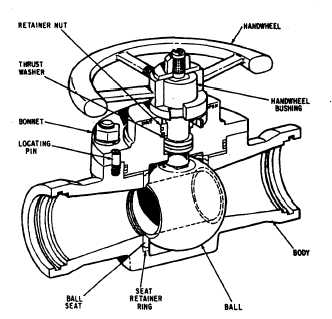CHAPTER 6
VALVES
It is all but impossible to design a practical
fluid power system without some means of
controlling the volume and pressure of the fluid
and directing the flow of fluid to the operating
units. This is accomplished by the incorporation
of different types of valves. A valve is defined as
any device by which the flow of fluid may be
started, stopped, or regulated by a movable part
that opens or obstructs passage. As applied
in fluid power systems, valves are used for
controlling the flow, the pressure, and the
direction of the fluid flow.
Valves must be accurate in the control of fluid
flow and pressure and the sequence of operation.
Leakage between the valve element and the valve
seat is reduced to a negligible quantity by
precision-machined surfaces, resulting in carefully
controlled clearances. This is one of the very
important reasons for minimizing contamination
in fluid power systems. Contamination causes
valves to stick, plugs small orifices, and causes
abrasions of the valve seating surfaces, which
results in leakage between the valve element and
valve seat when the valve is in the closed position.
Any of these can result in inefficient operation
or complete stoppage of the equipment.
Valves may be controlled manually, electri-
cally, pneumatically, mechanically, hydraulically,
or by combinations of two or more of these
methods. Factors that determine the method of
control include the purpose of the valve, the
design and purpose of the system, the location of
the valve within the system, and the availability
of the source of power.
The different types of valves used in fluid
power systems, their classification, and their
application are discussed in this chapter.
CLASSIFICATIONS
Valves are classified according to their use:
flow control, pressure control, and directional
control. Some valves have multiple functions that
fall into more than one classification.
FLOW CONTROL VALVES
Flow control valves are used to regulate the
flow of fluids in fluid-power systems. Control of
flow in fluid-power systems is important because
the rate of movement of fluid-powered machines
depends on the rate of flow of the pressurized
fluid. These valves may be manually, hydrau-
lically, electrically, or pneumatically operated.
Some of the different types of flow control
valves are discussed in the following paragraphs.
BALL VALVES
Ball valves, as the name implies, are stop
valves that use a ball to stop or start a flow of
fluid. The ball, shown in figure 6-1, performs the
Figure 6-1.—Typical ball valve.
6-1

